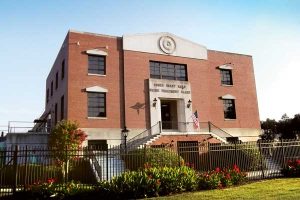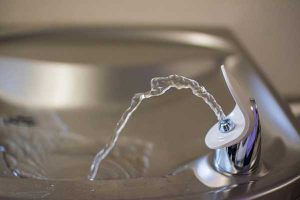Campus Drinking Water
Environment, Health and Safety (EHS) has a comprehensive, campuswide drinking water management program to ensure the health and safety of our students, faculty and staff. This program is supplemental to the required regulatory testing conducted by the Orange Water and Sewer Authority (OWASA), the campus public works authority. The program includes routine testing of drinking water fixtures for lead and testing for other parameters per requests, complaints, or new regulations.
Lead in Campus Drinking Water
EHS will conduct lead testing in drinking fixtures in buildings built prior to 2014 every three years. This follows the 2014 revision of the lead-free definition for plumbing fixtures outlined in the EPA Reduction of Lead in Drinking Water Act. Fixtures that test below the remediation level for three consecutive testing cycles are not required to be tested again. Remediated fixtures will be tested one year after remediation to ensure remediation achievement. As was done in the past, EHS will continue to test drinking fixtures for lead in newly constructed buildings prior to occupancy.
- Action level: 10 ppb of lead. This is the level when a drinking water fixture will be removed from service. This level will be reduced to 5 ppb for lactation room faucets.
- Drinking water: water used for consumption or cooking purposes.
- Drinking water fixture: fixture used for consumption or cooking purposes such as a drinking fountain, bottle filler or faucet.
- Limit of detection (LOD): 1 ppb of lead. This is the lowest level reliably detected by a given laboratory analysis method.
- Remediation level: 5 ppb of lead. This is the level when a drinking water fixture will be remediated.
- 5 ppb – the Food and Drug Administration (FDA) Bottled Water Standard for lead.
- 5 ppb – the level the Clean Water for Carolina Kids Program strongly recommends remediating fixtures in child care centers and public schools.
- 10 ppb – the NC Lead Poisoning Hazard level for drinking water in child care centers and public schools
- 15 ppb – the EPA Lead and Copper Rule action level (applies to public water utilities).
To address the harm of childhood exposure to lead and asbestos, North Carolina legislatures established two rules: 15A NCAC 18A .2816 of the North Carolina Child Care Sanitation Guidelines covering Lead Poisoning Hazards in Child Care Centers; and 10A NCAC 41C .1001-1007 Lead and Asbestos Inspection, Testing, Abatement, and Remediation in North Carolina Public Schools and Licensed Child Care Facilities. These rules require testing for lead in water used for drinking and cooking. If levels of lead are at or above the state hazard level of 10 ppb, centers are required to restrict access to the fixture. The Clean Water for Carolina Kids™ program, a legislatively mandated program, was developed to address lead water hazards in North Carolina public schools and child care facilities to meet state regulations. Although this program does not apply to universities, UNC-Chapel Hill has decided to conservatively follow this program.
Clean Water Habits
- Only use cold water for drinking and cooking. Hot water can leach lead, if present, from the plumbing into the water.
- Flushing drinking water fixtures to clear out standing water. Let fixtures run for at least 30 seconds prior to use.
Sampling for Other Parameters
OWASA conducts routine testing to meet federal and state regulations for drinking water. However, EHS may test for other drinking water parameters besides lead such as pH, various metals and total coliform at their discretion in response to complaints about water quality. EHS may also test for parameters associated with emerging issues such as per- and polyfluorinated Substances (PFAS) as more information, recommendations and/or regulations are available.
Well Water Testing
The University owns properties supplied by well water such as campgrounds at the Kerr Lake Recreation Area and rental houses. EHS will work with these entities to identify state testing recommendations and requirements. Currently, the well water at the Kerr Lake Recreation Area is tested quarterly and reported to the state.
Private well testing requirements are governed by the North Carolina Department of Health and Human Services (NC DHHS). After 2008, new wells are required to be initially tested by the local health department. There are no testing requirements for existing private wells constructed prior to 2008. However, NC DHHS recommends the following tests:
- Every Year: Test for total and fecal coliform bacteria. Also check the wellhead once a year to make sure it is working properly and ensure that there are no cracks or openings where contaminants can get into groundwater.
Also check the wellhead once a year to make sure it is working properly and ensure that there are no cracks or openings where contaminants can get into your groundwater.
- Every Two Years: Test for heavy metals, nitrates, nitrites, lead and copper.
- Every Five Years: Test for pesticides and volatile organic compounds (VOCs). If a particular pesticide is applied in the area, test yearly.
OWASA “Boil Water Advisory”
Occasionally, OWASA may issue a “Boil Water Advisory” if an event occurred that potentially allowed contaminants to enter the water system. EHS will notify building contacts of advisories affecting their buildings and request contacts to place notices of the advisories on the entrances to the buildings.
During advisories, building occupants should boil tap water before using it for drinking, making ice, washing dishes, brushing teeth or preparing food. Bring tap water to a rolling boil for at least one minute and let it cool. Bottled water can be used during advisories.
Once the advisory is lifted, EHS will notify building contacts and ask them to remove the notifications.
If you have further questions, please contact Occupational and Environmental Hygiene.
News and Resources
 Temporary Change in OWASA’s Water System Disinfection Process in March
Temporary Change in OWASA’s Water System Disinfection Process in March
Beginning at 12 a.m. March 1, 2024, OWASA will temporarily alter its drinking water treatment process.
Categories: Water Safety News
 Updates: Lead Testing and Corrective Action/Remediation
Updates: Lead Testing and Corrective Action/Remediation
Environment, Health and Safety (EHS) with the assistance of Facilities Services has remediated the majority of the drinking water fixtures with detected lead identified during the campus-wide testing.
Categories: Lead in Campus Drinking Water
 OWASA Testing Campus Sewer Systems June 12-30
OWASA Testing Campus Sewer Systems June 12-30
The Orange Water and Sewer Authority (OWASA) will push non-toxic smoke through the sewer system to help determine if there are leaks or other issues in sewers or storm drains.
Categories: Water Safety News
External Resources
- No-cost and Low-cost Solutions to Lead in Drinking Water (Source: Clean Water for Carolina Kids)
- Flushing Best Practices (Source: U. S. Environmental Protection Agency)
- 3Ts: Training, Testing and Taking Action Manual (Source: U. S. Environmental Protection Agency)
Policies and Training
- What is the source of the drinking water for the main campus?
- The main UNC-Chapel Hill campus receives its tap water from OWASA. OWASA’s water supply originates as rainfall within the Cane Creek Reservoir and University Lake watersheds.
- What types of fixtures are being tested in campus buildings?
- The following are considered drinking water fixtures and will be tested:
- Drinking fountains
- Bottle fillers
- Taps, faucets, and kettle fillers in breakrooms, kitchens and cafeterias that are used for drinking, cooking or preparing food
- Ice machines, if the ice is used for drinking, cooking or preparing food. (Note: ice machines are usually connected to sink plumbing and do not have metal components. EHS will test if there is concern with sink plumbing connected to ice machines.)
The following are not considered drinking water fixtures and will not be tested:
- Bathroom taps and faucets
- Laboratory faucets
- Housekeeping closet sinks
- Eyewash stations
- Showers
- Shop taps and faucets
- Hose spigots and ice machines, if they are not used for drinking, cooking or preparing food.
- How often are drinking water fixtures on campus tested for lead?
- There are no federal or state regulations requiring colleges and universities to test for lead in drinking water sources. The University has decided to conservatively test drinking water fixtures on campus in buildings built prior to 2014 every three years as a supplement to the required regulatory testing conducted by OWASA, the campus public water utility. Fixtures that test below the remediation level for three consecutive testing cycles are not required to be tested again.
- Will drinking water fixtures be removed from service during the testing process?
- Fixtures will be removed from service during the 8- to 18-hour stagnation period prior to sample collection. Once the sample is collected, the fixture will be placed back in service. Therefore, water coolers will not be provided during the testing process.
- Will I be notified when testing occurs in my building?
- For initial testing, EHS will notify building contacts of pending testing at least one week prior to sampling. The notification will outline what to expect during the testing process. Once the results are received, EHS will provide a summary of the results to the building contact including which fixtures will require remediation. The detailed sampling results will be provided on the Campus Drinking Water webpage.
- What signs should I expect to see during the testing process?
-
- EHS will place a “Testing in Progress” sign on fixtures during the 8- to 18-hour stagnation period. The sign will be removed once the sample has been collected.
- EHS will place a “Remediation in Progress” sign on fixtures with levels at or above the remediation level. The sign will be removed once the levels are below the remediation level.
- EHS will place a “Handwashing Only” sign on fixtures that will not be used for consumption or cooking purposes.
- EHS will place an “Out of Service” sign on fixtures that are at or above the action level and the remediation process has not started or have been disabled for use as a remediation action.
- What should I do if I have a concern or complaint about general water quality?
- If you have a complaint associated with the color, taste or odor contact EHS at 919-96-5507 to request an evaluation. If you are an employee with a health concern, please contact the University Employee Occupational Health Clinic (UEOHC) at 919-966-9119. If you are a student and have a health concern, please contact Campus Health at 919-966-2281. Non-student and non-employee community members and visitors who have health concerns should consult with their physicians.
